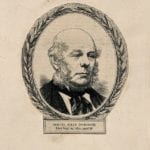Arpan K. Banerjee
Solihull, UK
 |
| Samuel Solly. Wood engraving, 1871. Credit: Wellcome Collection. (CC BY 4.0) |
Samuel Solly was born in St. Mary Axe, London, on May 13, 1805. He attended school in Walthamstow, East London, where his contemporaries included the future British Prime Minister Benjamin Disraeli.1 In May 1822 he became an apprentice to Benjamin Travers, a surgeon at St. Thomas’s Hospital.2 For this privilege he had to pay a large fee, a practice that was later discontinued. In 1828 he became a member of the Royal College of Surgeons, an institution which in 1800 had received a Royal Charter. Next he went on to complete his surgical training in Paris. In those days pupils in the UK did not have to attend medical school before beginning their surgical training. (This new requirement was introduced in the 1830s after a successful campaign by the Royal College of Physicians, founded in 1518 by Thomas Linacre and by then the preeminent medical organization in Britain.)
In 1834 Solly married Jane Barrett and they had eleven children.3 He started private practice from his father’s house but later moved to Saville Row, now famous for its shops selling bespoke suits. From 1833-1839 he was lecturer in anatomy and physiology at St. Thomas’s Hospital, where he acquired a reputation as a fine teacher. In 1836, his annus mirabilis, he published The human brain its configuration, structure, development and physiology, illustrated by references to the nervous system in the lower order of animals. The book ran to 492 pages and had 544 images.4 It established Solly’s reputation as an expert in neuroanatomy and neurophysiology. The text was expanded in a second edition in 1847. In 1836 Solly was elected to the prestigious Royal Society of London. He was appointed assistant surgeon at St. Thomas’s Hospital in 1841 and full surgeon in 1853. He was a much-loved teacher and a skillful surgeon.
Becoming a full fellow of the Royal College of Surgeons in 1843, he served in several roles, including examiner in 1867 and council member for several years. He was also professor of anatomy and surgery and in 1863 became an Arris and Gale lecturer. He rose to the rank of Vice President of the Royal College of Surgeons but was passed over for the Presidency.
In 1866/1868 he was President of the Royal Medical and Chirurgical Society in London. This was an amalgamation of medical societies that met for educational events and had broken away from the Medical Society of London in 1805. It was the forerunner of the Royal Society of Medicine in Wimpole Street founded in 1907, which continues to flourish to this day and is heavily involved in medical education.
Solly was one of the first to describe Von Recklinghausen’s disease and its bone changes.5 In 1865 he published Surgical experiences: the substance of clinical lectures. This book ran to 656 pages and was well-received.6
In 1868 he gave the commencement address to the 1867-68 medical school class of St. Thomas’s. This was published, and to this day makes interesting reading. He dedicated the book to Queen Victoria for laying the stone of the new hospital.7 In this address he reminded the students that “Life is not a toy given to amuse us; our life is a shadow and soon passes away. To prolong this short life is the object of the science which you have come here this day to study . . . and remember that the surgeon cannot bury his mistakes as the physician.”
Solly’s health deteriorated after being passed over for the Presidency of the Royal College of Surgeons and he died on September 24, 1871. His legacy at St. Thomas’s Hospital includes an annual awarding of a medal in his name to a medical student at that institution.
References
- Obituary. Samuel Solly. Brit Med Journal 1871 2 p.3 95.
- Solly S. King’s College Archives, London.
- Robinson B. St Thomas’s Hospital Surgeons. St Thomas’s Hospital Reports 1899, p.445
- Solly S. The Human Brain: Its configuration, structure, development, and physiology: illustrated by references to the nervous system in the lower order of animals 1836 London: Longman.
- Solly S. Remarks on the pathology of mollities ossium. With cases 1844 London R Kinder.
- Solly S; Surgical experiences: the substance of clinical lectures 1865 London Robert Hardwicke.
- Solly S. Introductory address to the session of 1867-68 of the medical school of St Thomas’s Hospital 1868, London, Wm H Allen and Co.
- D’Arcy Power. Samuel Solly Dictionary of National Biography 1885-1900 Vol. 53
ARPAN K. BANERJEE, MBBS (LOND), FRCP, FRCR, FBIR, qualified in medicine at St. Thomas’s Hospital Medical School, London. He was a consultant radiologist in Birmingham from 1995-2019. He served on the scientific committee of the Royal College of Radiologists 2012-2016. He was Chairman of the British Society for the History of Radiology from 2012-2017. He is the Treasurer of ISHRAD and adviser to radiopaedia. He is the author/co-author of numerous papers and articles on a variety of clinical medical, radiological and medical historical topics, and seven books including Classic Papers in Modern Diagnostic Radiology 2005 and The History of Radiology OUP 2013.

Leave a Reply